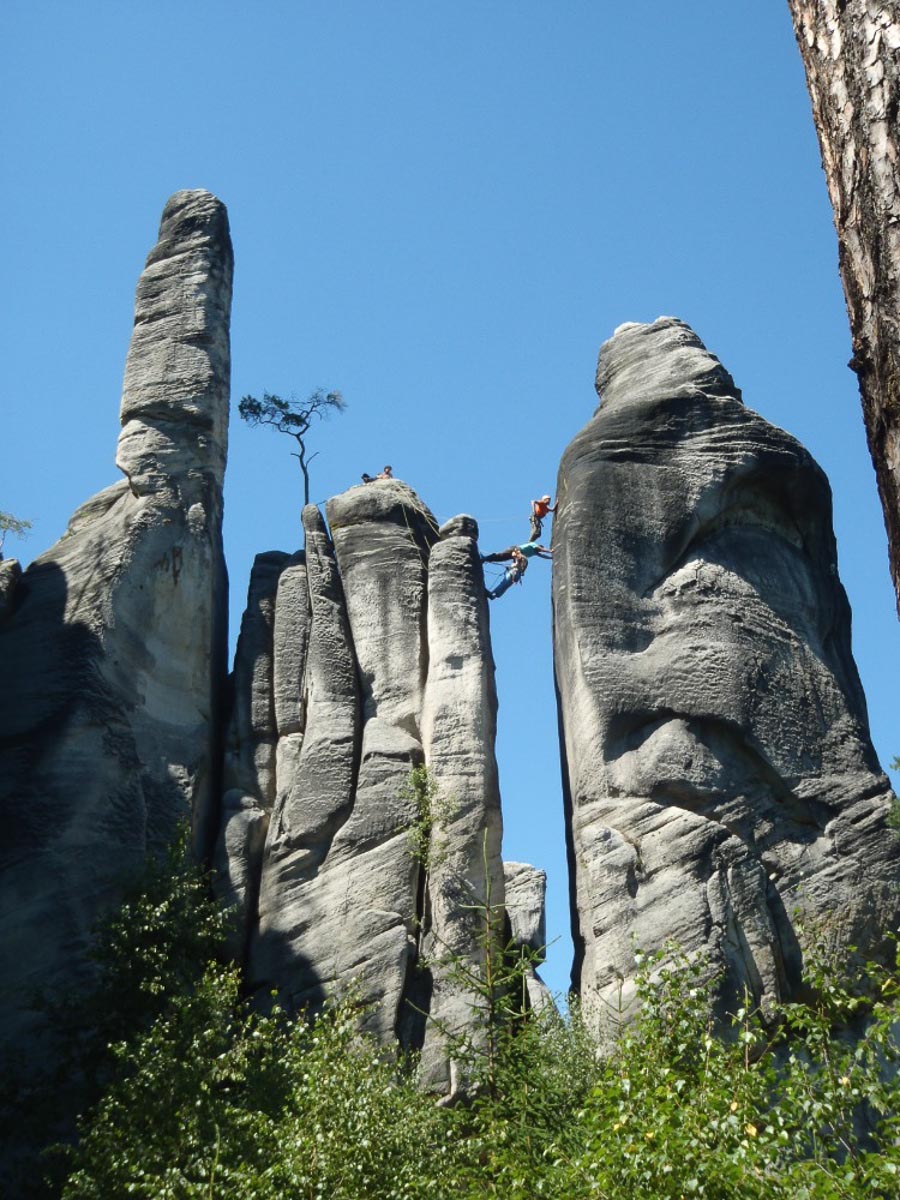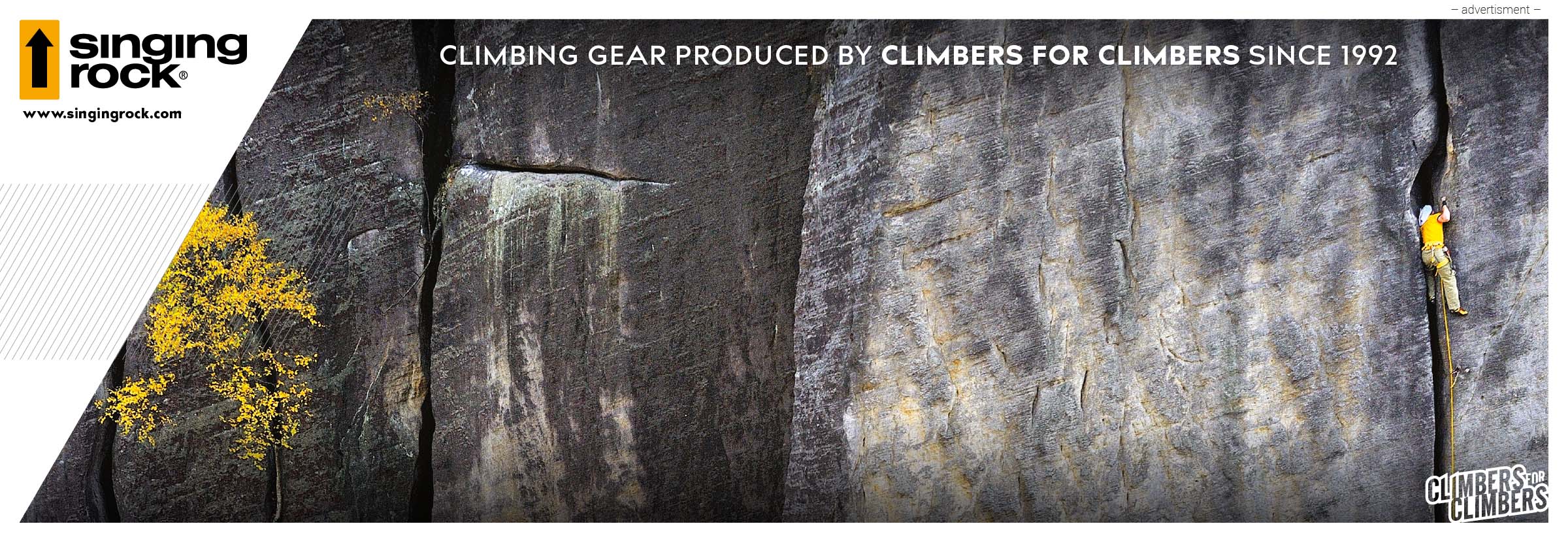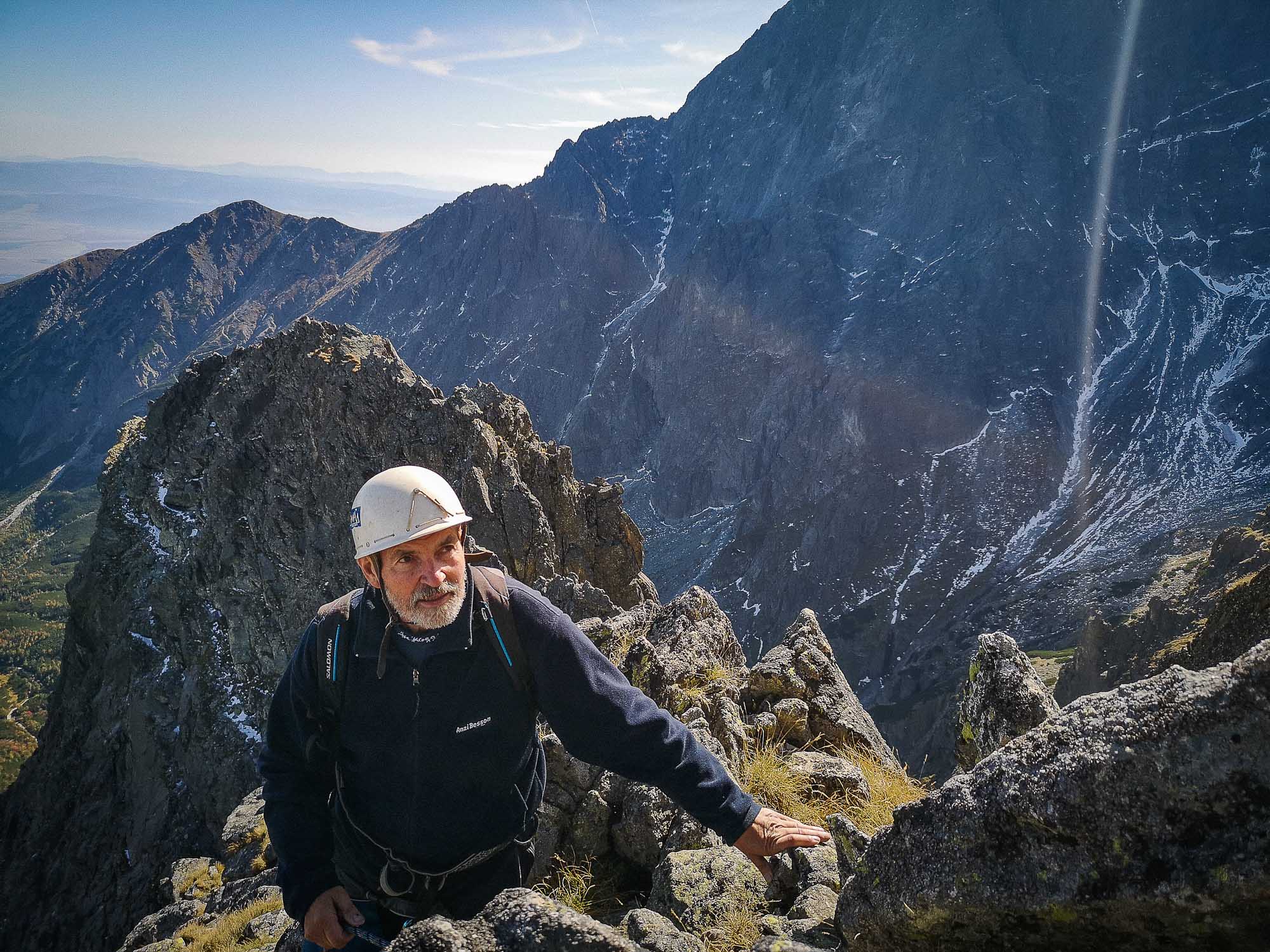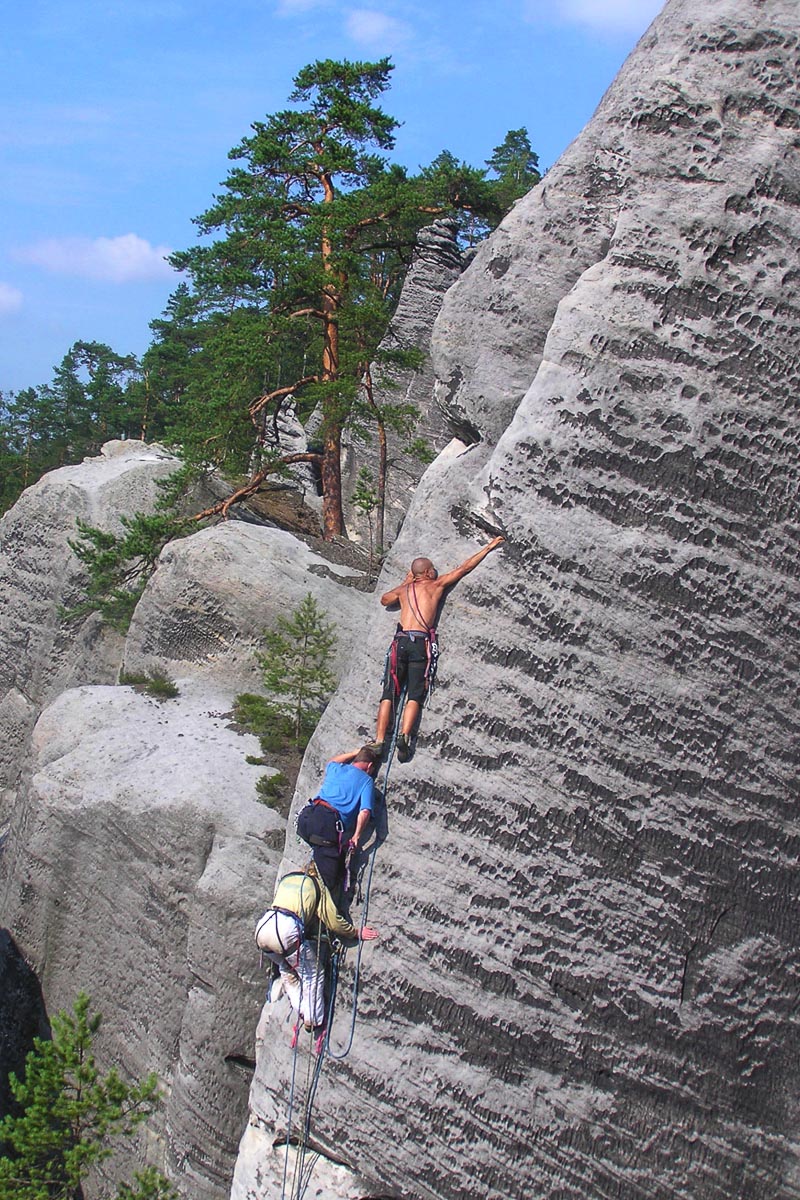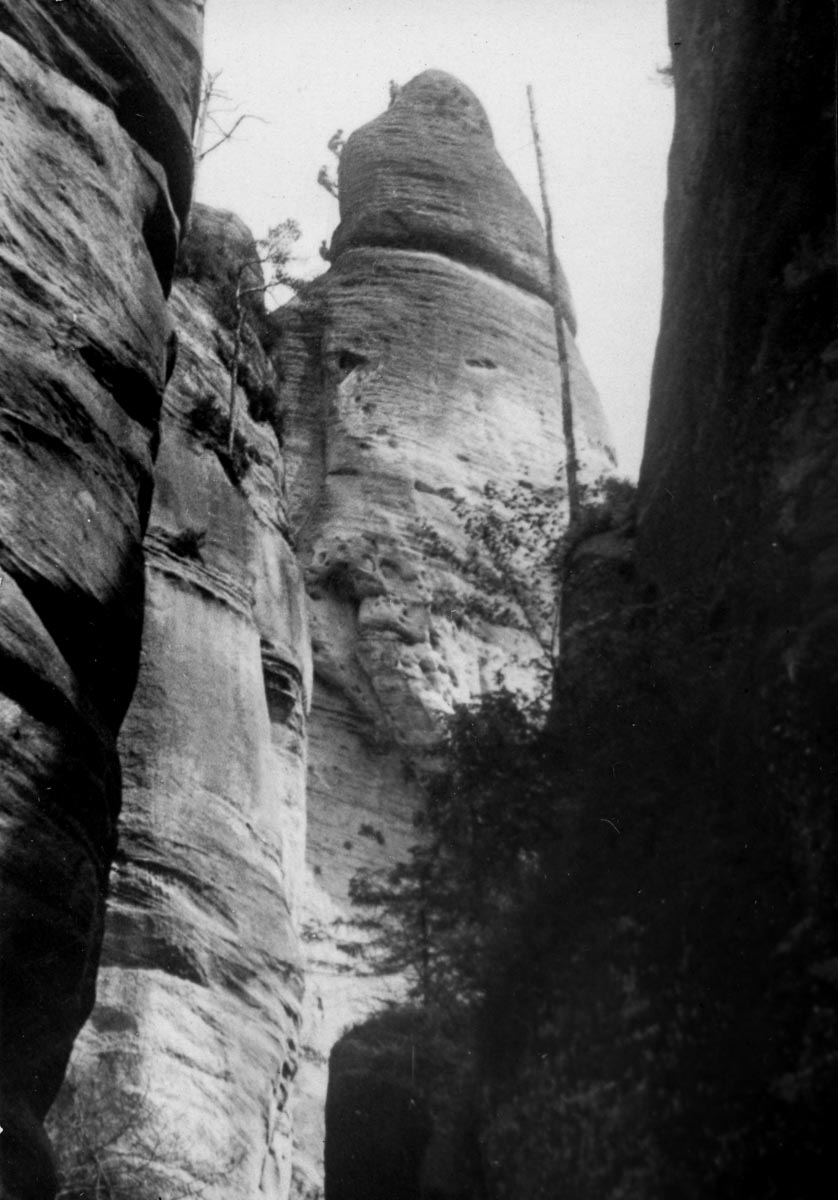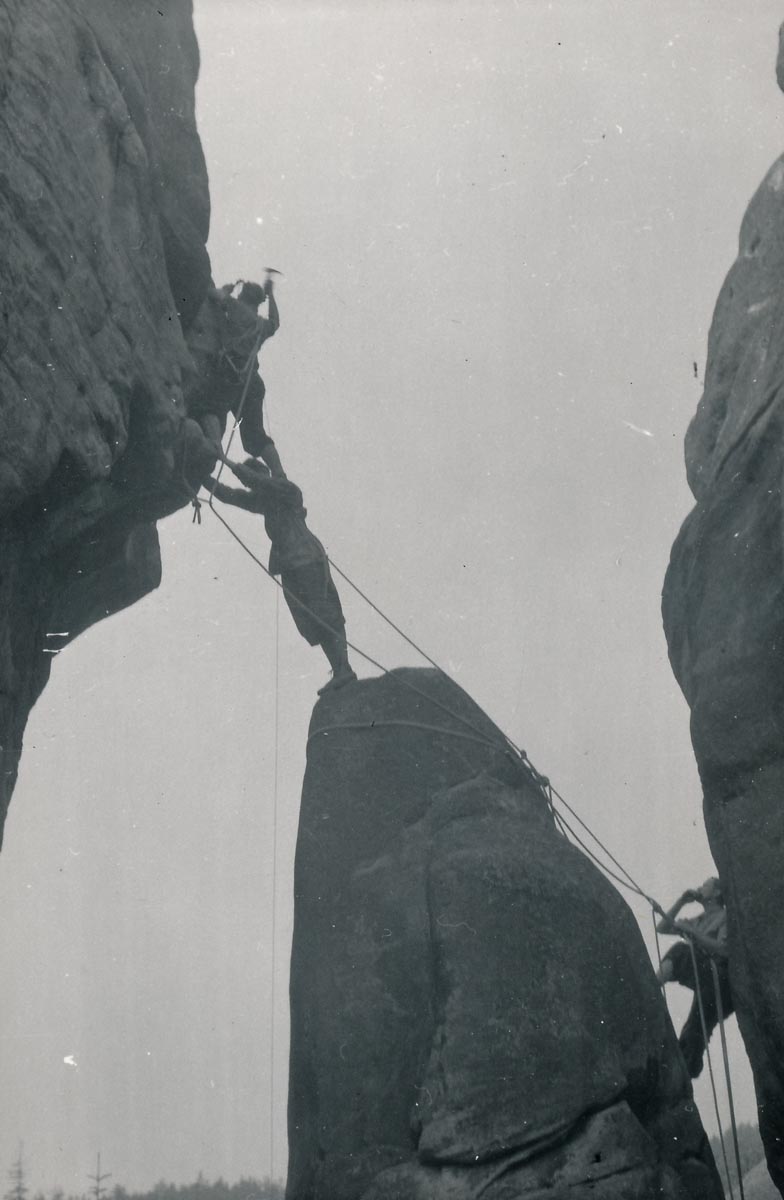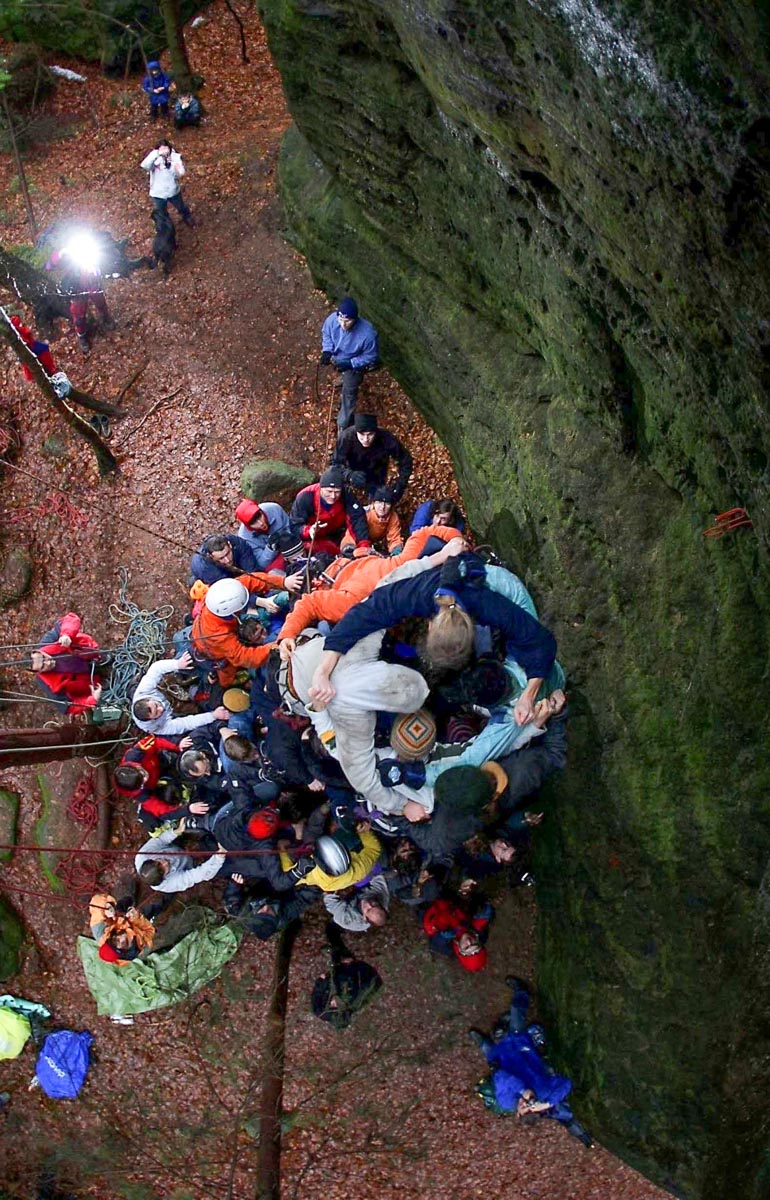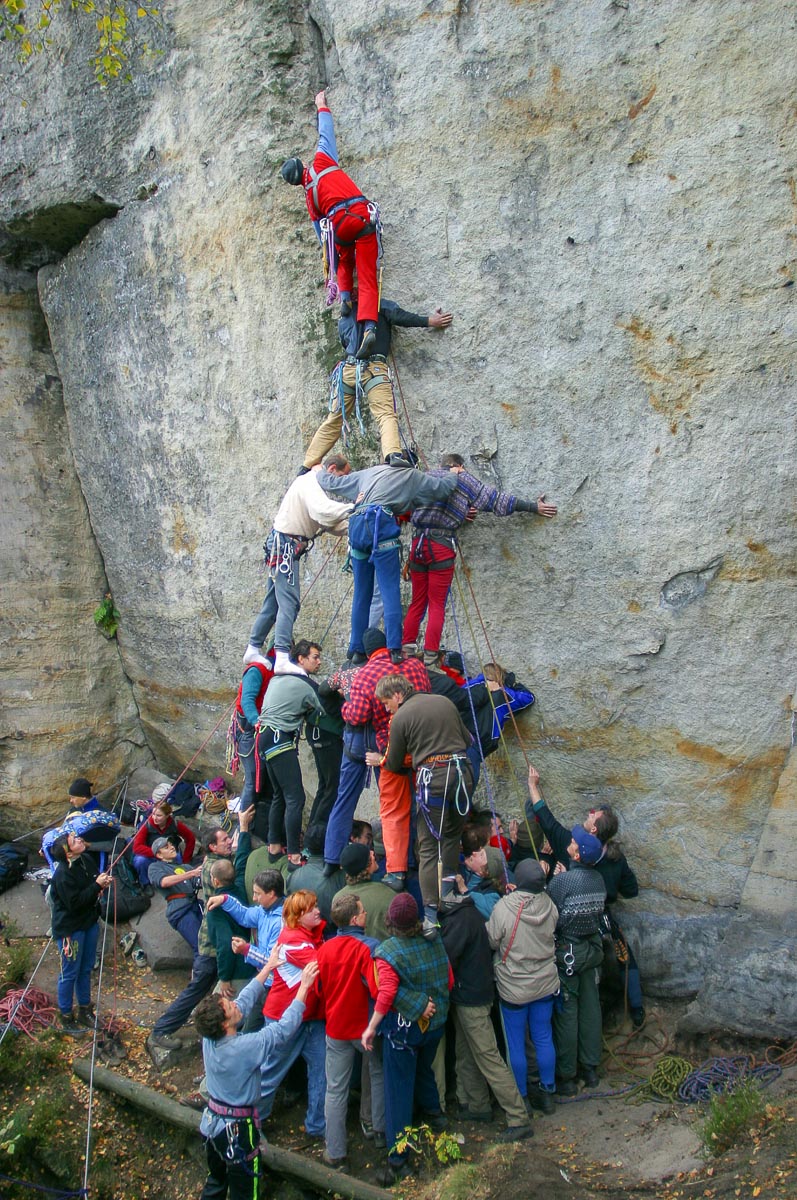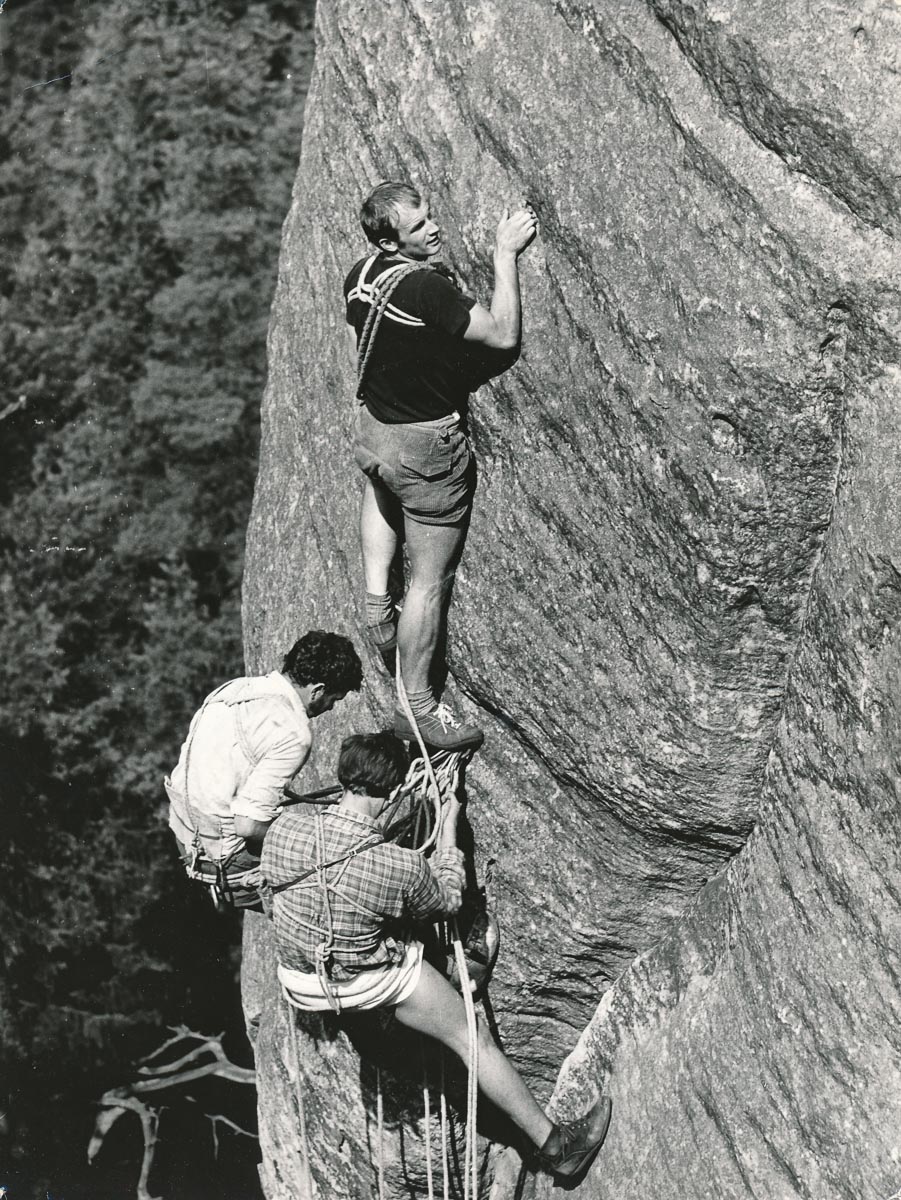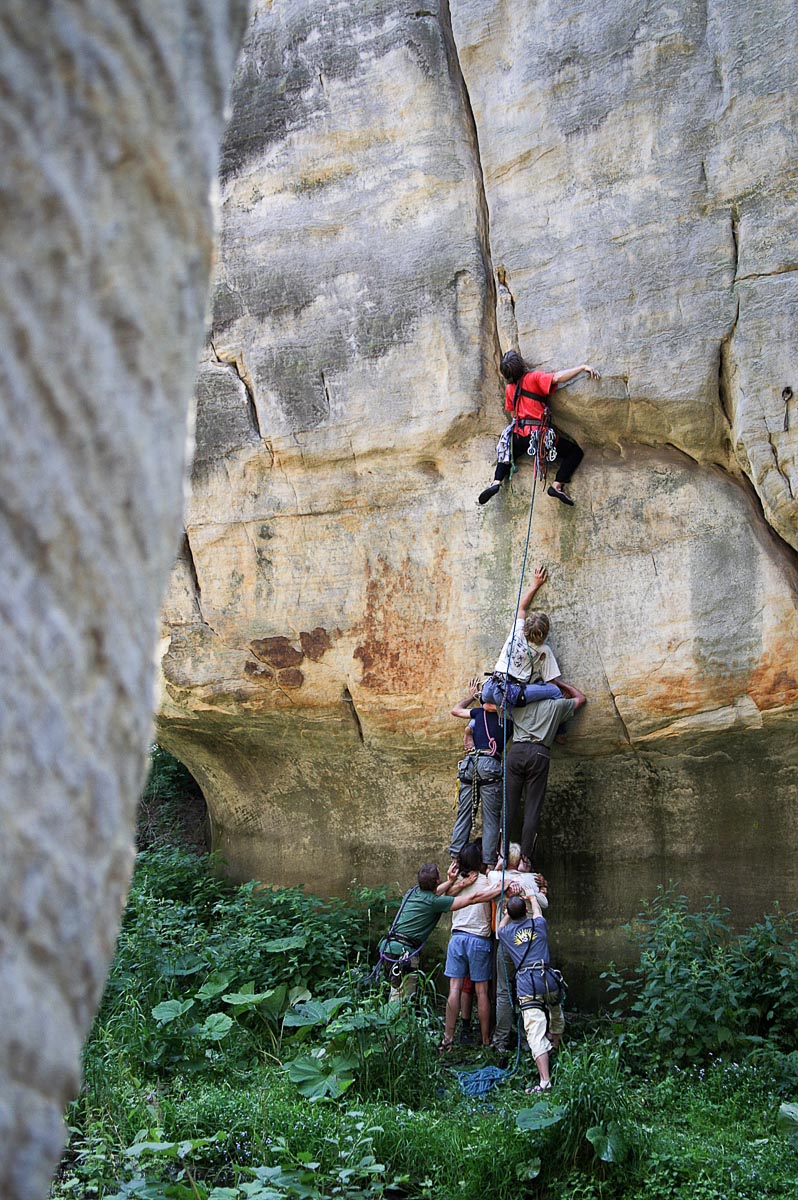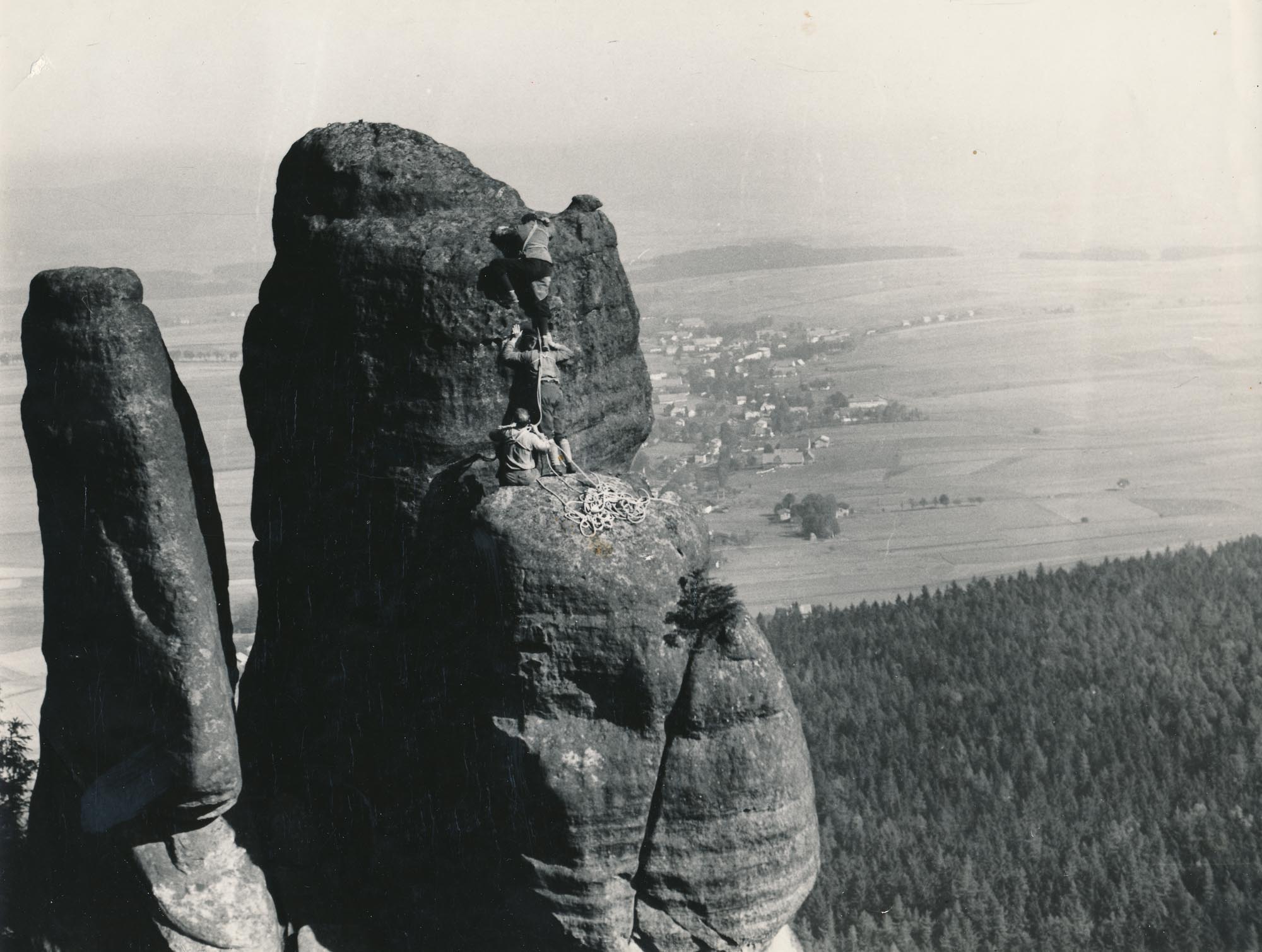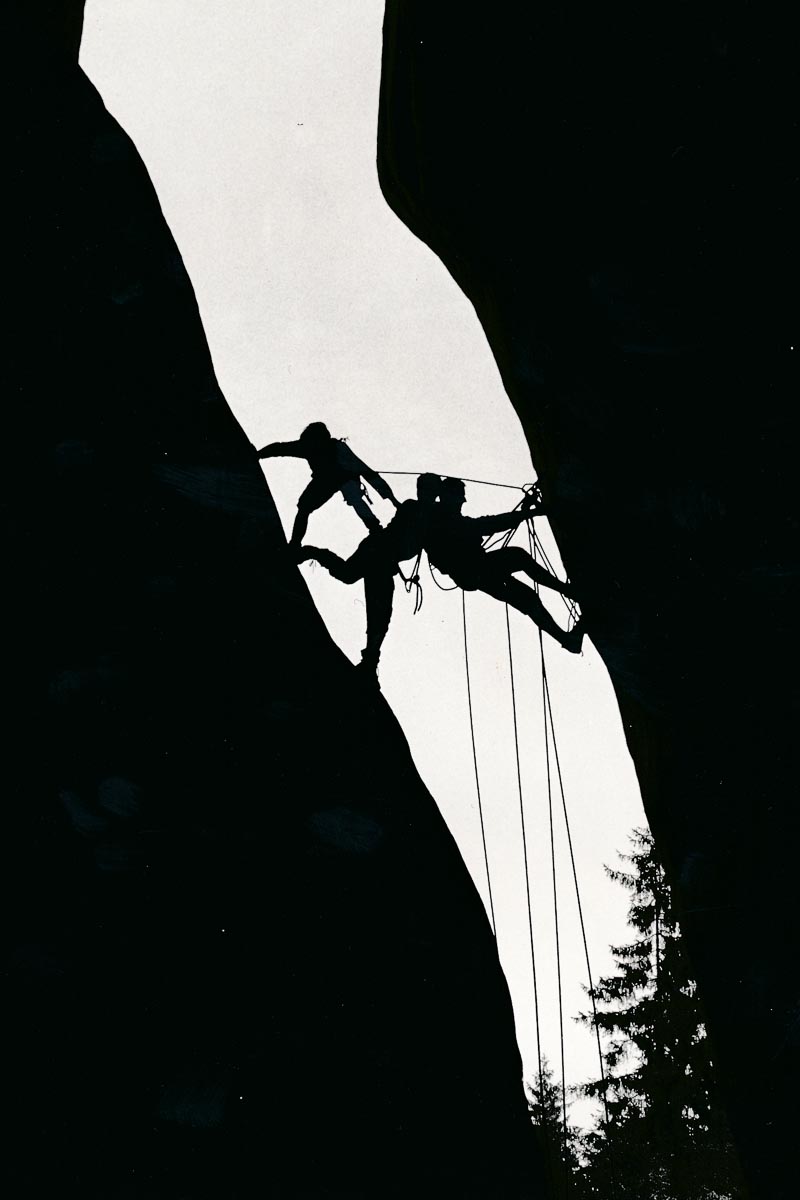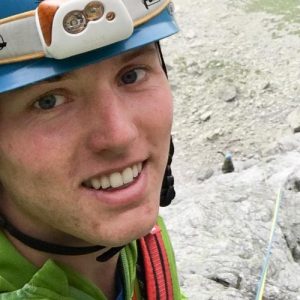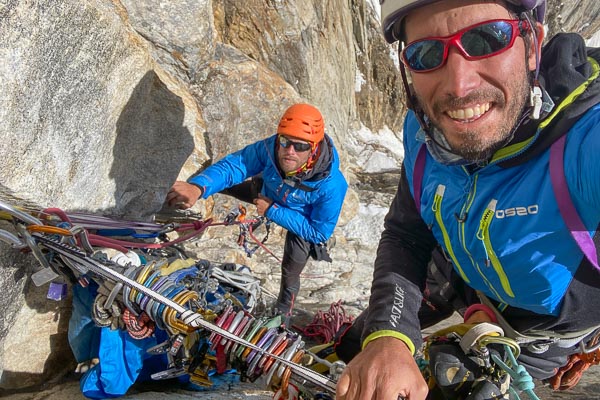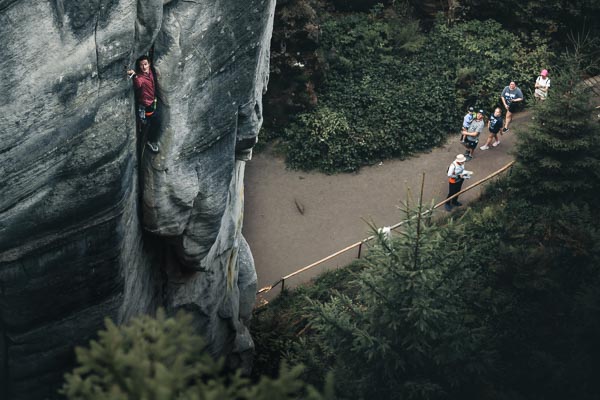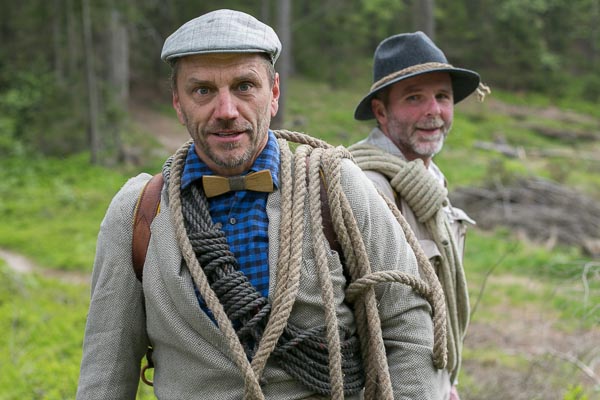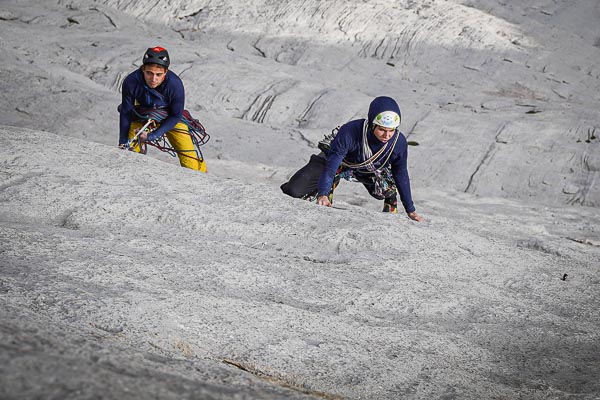CLIMB ON ME!
The major advantage of “building” is that even when you fail, you return home with great stories. Let’s hear some of those from a Czech sandstone climber and a local building legend, Jarda “King” Seifert.
COUNTING THE JOY
“I feel like the RP style robbed us of friendships that accompanied sharing a single rope.” I first heard this idea in an interview with the legendary sandstone climber Bernd Arnold (not translated into English yet, editor’s note) and it keeps coming back to me ever since. There are certainly routes that I want to CLIMB FOR MYSELF – I train for them and maybe even keep them secret from my friends, just to be the first one to send and experience them and perhaps to bring back some adventurous story.
That’s fine – in fact, it’s often one of the most important driving forces behind one’s growth, both personally and as a climber. But what about the climbing partners who are willing to return to routes you have been trying with them for years, and which you bailed more times than you could even remember? What about the routes WE CLIMB TOGETHER?
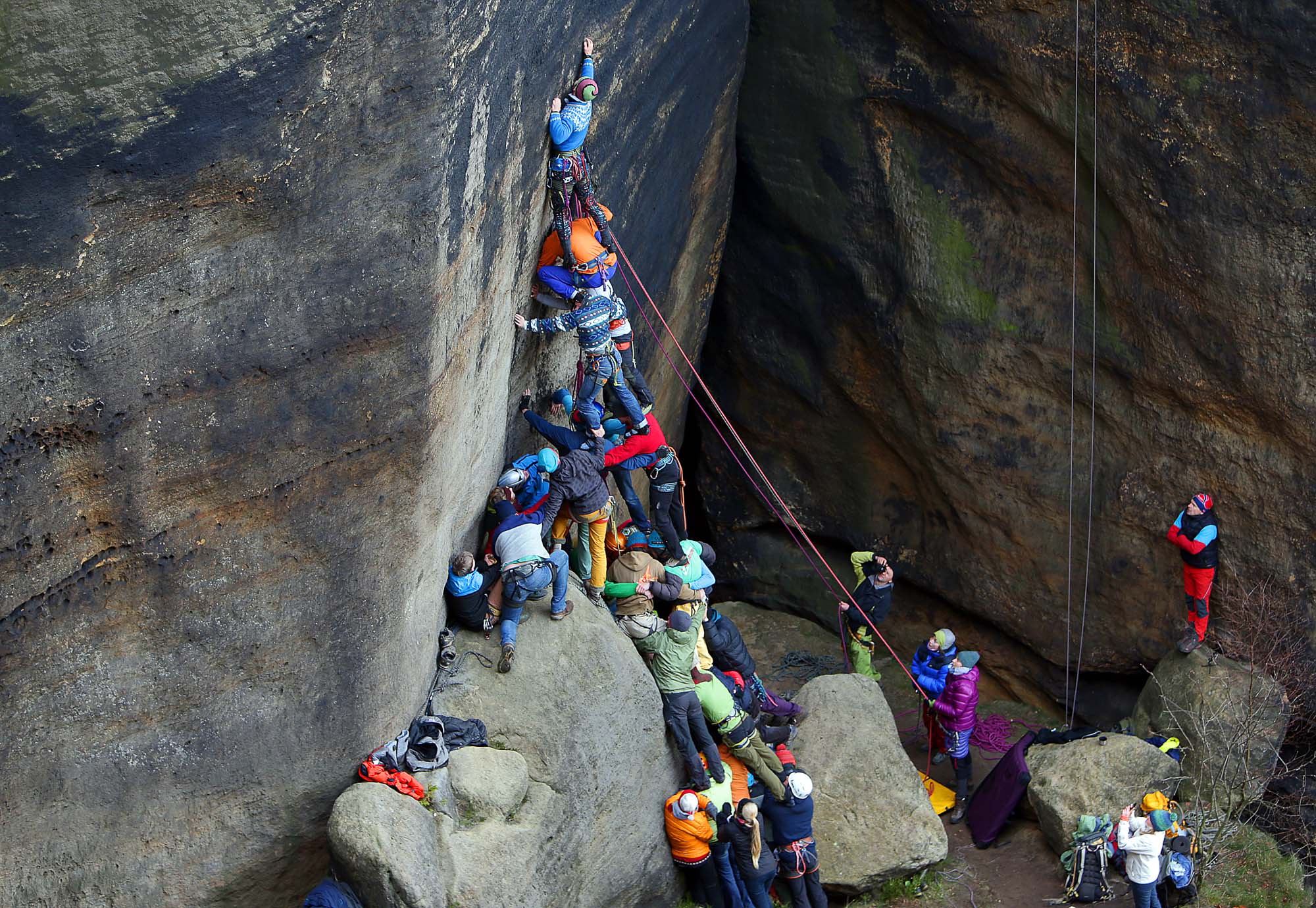
In the traditional sandstone areas of the Czech Republic and Saxony, one can find gems in which you rely heavily on your climbing partners. In such routes, you need a hand of your partner or you come short of reaching the anchors… literally. Most of these lines can be climbed RP just by a small group of the chosen ones and some are even not compatible with the usual climbing styles at all. The typical crux on these lines is simply a smooth patch of rock… the jugs are too far and the crimps nonexistent. The last option you have is to belay your partner(s) up to the ringbolt, working together on solving the riddle, and building a bridge across the unclimbable space. There is a saying that goes: “When climbing in pairs, the joy of reaching the top of the tower doubles.” If we apply this theory to the amount of joy you experience after reaching the top by the method of building, it must be at least raised to the power of two.
The preparation for such a classic building event (in British English sometimes called “combined tactics”, ed.) at sandstone resembles a good theatre act. Besides the fun, this method allows you to discover many hidden talents in your friends – suddenly, it seems that they should have picked another job. Everybody turns into an engineer, architect, and there you have the chief builder, and even an expert on suspension bridges. Of course, each of them brings up a theory which must be the only right one. Finally, silence falls on the group when somebody drops the question who’s going to be the first to test the whole living structure. A few moments later, the theorists come up with clever answers… naturally, the lightest of the bunch… or the tallest one?
SOLID FOUNDATIONS
Interview with “The King of Building”
This sandstone-specific discipline is not about chasing numbers at all. You can’t find it anywhere else in the world and the guidebooks won’t tell you much about it – you must ask around in local pubs or eavesdrop the heroic stories of the seasoned sandstoners. Among the climbers famous for their “building” skills, one name stands out in particular – Jaroslav “King” Seifert. Born in sandstone area Policko, this guy have made many outstanding first ascentsboth in our local sandpit and in the far mountains of Hogar located in the Algerian part of Sahara, or not-so-far Alps (the west face of Piz Badile) and in the Himalayas, where he went in 1976 and was a part of a successful expedition to Mt. Nun (7135 m).
“I like building. For me, it’s an essential part of the sandstone climbing. And it always adds some spiciness to the routes. As a part of the human pyramids, I was mostly used as a solid foundation. I took part in one famous building event where I actually got to climb and luckily there was a photographer who managed to take a good shot of it,” he recalls one of the famous human pyramids in the history of Czech sandstone climbing.
What was going on? The first ascent of the “Pouťová varianta” VI (“Fun fair variant”, approx. 4c fr.) route on the Budík tower. The grade seems quite low, but don’t let yourself be fooled! It’s a true challenge that calls for a pretty social event as well. This route is often climbed when a fun fair comes to the town of Police, and that’s where it probably got its name from. To climb this route, you need a large party of strong climbers. Some pyramid building skills come in handy as well – four people at the base, on their shoulders two others, and only after that, you can get a climber to reach into the crack.
Naturally, the first attempt ever involved a spectacular falling incident – the pyramid went down, but luckily, Jarda “King” Seifert managed to hold on and finish the route: “I shouted at them to throw me a rope (“King” was climbing it solo) and jug up – that’s how we’d been usually doing these building ascents. But nobody wanted to follow me, so I had to be the only one mentioned in the tower logbook as the author of the route,” describes “King” the memorable first ascent at Ostaš. “It’s definitely one of those routes that keeps reminding us how short we are.”
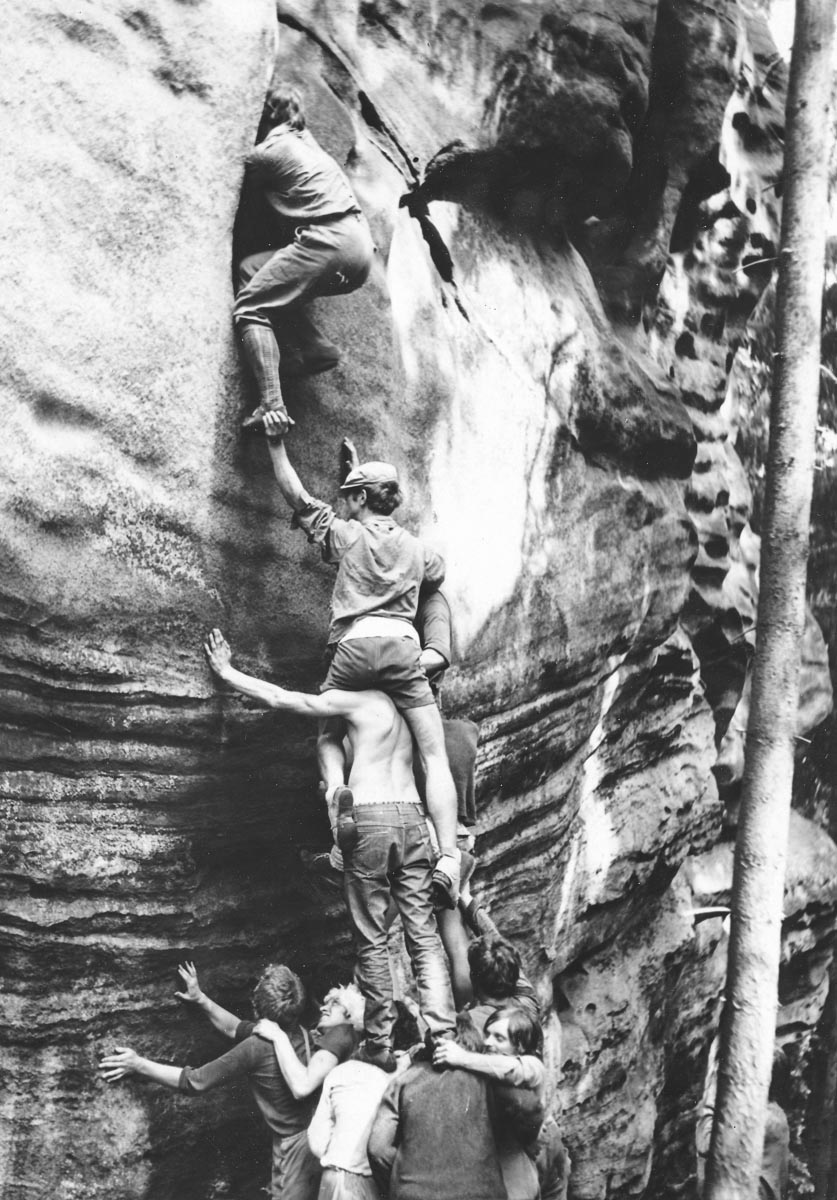
INTO THE GUTTER
Are there any other memorable first ascents that you would like to mention?
There’s another adventurous building route at the Šikmá tower in the Ostaš area. One day, my pal Miloš Nosek and I thought: “Man, this tower looks promising!” So, I climbed as far as I could and ended up in a small arched cave, where I held on and placed the first ring. You’re standing on a solid wide ledge, the holds are good, but the next meter is completely blank – at least it was blank for us back then (he laughs). Of course today, somebody has already free climbed it. I belayed Miloš up to the ring and we started working the crux. With two persons up there though, it all got even more complicated. There was nobody to belay us, so I put Miloš on a long piece of fixed rope, climbed back into the cave, and clipped into the ring, which was placed just beside me. When he managed to reach into relatively good pockets, I swung back, unclipped him from the fixed rope and we continued. (The route is „Kartáčová stěna“ VIIb or RP VIIIb, that is f5c/f6b, at the Šikmá tower in the Ostaš area).
Do you recall any tough building, which was both difficult and dangerously exposed?
That could be the route called „Hydraulická“ on the tower Rusalka. I even think that it was the first route ever made on that tower. You climb a grade III route onto the leaning rock on the side which is topped by a huge boulder. The rest remains to be unclimbable. So, we put a sling around that boulder and the three of us clipped into it. I crouched, Gustav Lamek climbed to my shoulders, and then Vláďa Horák got on top of him but that was just the beginning. First Gusta, the middle guy, stood up and then I raised both of them – so it had to be around three meters without any holds. I still admire Vláďa for making those following slab moves.
Clean/Saxon building – All ropes, slings, etc. are loose and are used only for belaying.
Building from the sitting position – Ropes and anchors bear the weight. Considered to be less ethical.
Multiple building – involves more than two-story human pyramid. This one can be either done in Clean or Sitting way.
I’ve heard about some “Stone skipping trial” route at the Králíkárna tower.
Králíkárna? Yeah, that was a strange route. I wonder if anybody has managed to climb it since then. It looked like a promising route but the problem was that right at the start, there was a meter of completely blank rock. There’s a large hole just above the ground, which is an exemplary hand crack. And as the saying goes, a hand jam is safer than a ring bolt. But then, the jam just disappears. So I jammed my hand inside the crack, grabbed my wrist with the other hand and served as a human anchor for the building. Good footholds and a solid hand jam – that’s all you need. Then a friend climbed upon my shoulders, reached into some holds and placed a ring. What follows is a nasty wet route – but the point is that it can be climbed and that it involves an unforgettable building move. (“Pekáčová” VI / f4c on the Králíkárna tower in the Bišík area)
TO THE REAL ROCKS
It seems that your stories are getting closer to Adršpach – so have you got any similar story from the Teplice area?
Of course, for example right in the central Amfitéatr area on the Krápníková (Dripstone) tower. One day, when we were walking past it and admired those dripstones, we’ve discovered a beautiful crack. Of course, it didn’t take long and we set out to try it. I climbed through the first crack onto a balcony where two birches grew, belayed my friend up there and he told me: “It’s gonna be just a few moves from here. And I can even see some solid thread over there.” I started climbing, reached into the pocket that looked like a typical thread for a good sling, and… it wasn’t. I shout back: “Dude, that’s no thread!” I found out that it was just two separate holes beside each other – there was still a centimetre of solid rock preventing them from becoming the typical sandstone thread, a bomber sling placement. Anyway, that wouldn’t be such a problem if I already wasn’t 8 meters above the anchor. I can tell you, I wasn’t happy about it at all.
So I had to hold on to that “almost-thread”, let down my rope to which Vašek tied a hand drill, I drilled in with just one hand and then we placed a ring up there. What follows is about four meters of wall climbing up to the next ring and then a sort of off-width crack to the ledge,from which you need to do a three-man building to the top. Karel Šimek and Láďa Horák were making another first ascent right next to this route. They climbed up to the ledge but they were only two. Láďa told to me: “There’s a building written in the tower book, but we haven’t got past it.” What they were missing was another climbing partner and perhaps a ring which we haven’t placed up there. You see, the ledge is so big that there’s no reason to fall from it. (he laughs) So it would have been pointless to spend an hour placing a ring. After such a feedback, we have graded it “a multiple building” after all. („Údolní“ VIIa /5b fr. to the tower Krápníková in Teplice area)
So, we have finally got to the Adršpach. You’ve done plenty of routes with the legendary Standa “Cikán” (“Gypsy”) Lukavský there. Do you remember any first ascents you’ve done with him?
We sure did a lot of first ascents together, because I actually brought him to Adršpach. We met in 1969 on a trip to the Dolomites. At that time, he was climbing mostly in the area called Hruboskalsko and around Drábské světničky, so I told him: “You better come to some real rocks – to Adršpach!” And then, one day, he just turned up. I think the very first ascent we did together was on the Mořská panna tower.
When it comes to building with “Cikán”, I remember one route in particular – “Ťuhýk”. It’s one of those shabby small towers. When you’re admiring the “Bílá růže” route at the Koberce tower in Adršpach, it’s the rock you’re leaning onto with your back. That’s where we met that day: “Piskoř”, “Cikán”, Mocek, Franta Půlpán, and I. We came there because “Piskoř” told us that he had a project there. You start it with a crack that leads onto a half-meter wide balcony and continues with yet another crack. But that crack starts around three to four meters above the balcony and quite typically, it is more of a shallow gutter where is not much to hold on to. “Piskoř” already placed a ring at the balcony, so all four of us climbed up to it. Then Franta Půlpán and I held each other’s shoulders and a third person climbed on us. When the fourth went up, he could reach into the crack elbow-deep.
“Cikán” tried it first but after a while, he climbed back down over us, cussing: “I can’t do that!” So another person went to try it. Franta got to the same point, tried it for a while and then went back down the same way as “Cikán” did before. It was Mocek’s turn then – we changed our positions and up he went. He could reach a little further and managed to get a good hand jam. As soon as he did the first move up from “Cikán’s” shoulders, we all ducked away to safety in case he would have fallen on our heads. Finally, he managed to climb it and the result was yet another nice first ascent. („Kvak“ VIIc/5c+ on Ťuhýk tower, Adršpach)
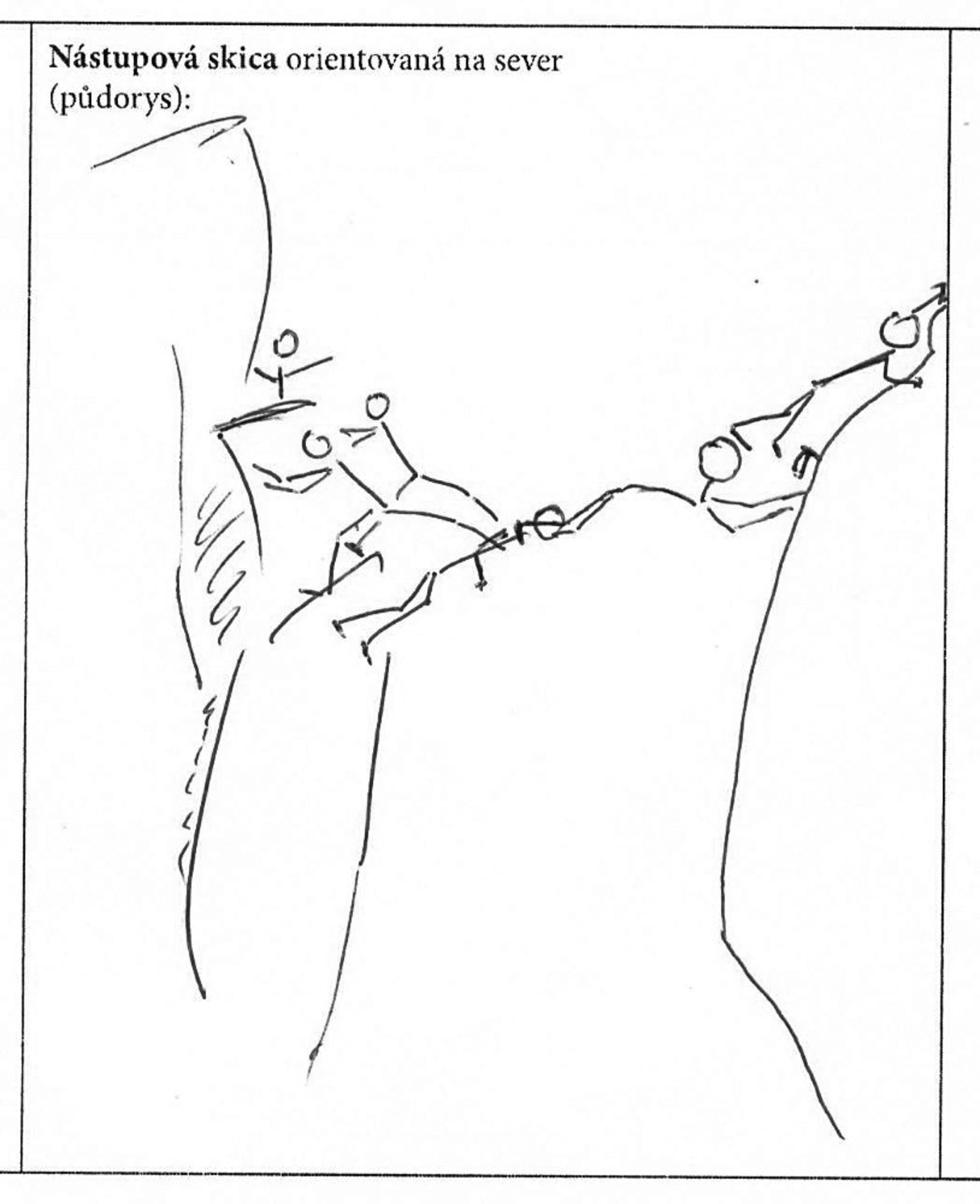
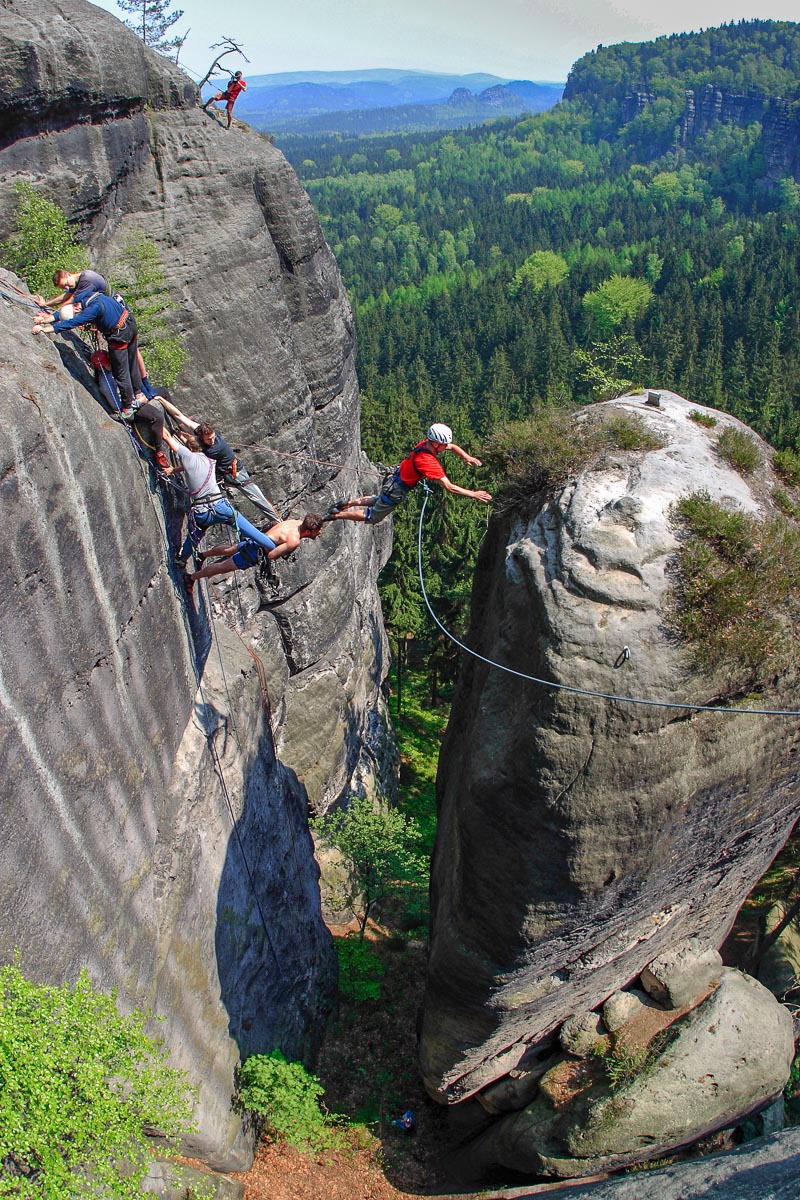
CHRISTMAS CARD
Do you recall any other adventurous building that you’ve done with Mocan, the local legend?
I’ve been through some adventures with this guy. He’s almost the same age as me. We often went for walks into the rocks, searching for routes that we could climb. Once, we managed to find a yet-unclimbed small tower just below the tower Polední. It was a chimney followed by a crack. But again – the chimney was quite wide and a one couldn’t really reach into the crack from it.
“Cikán” went for it but it was too far, and he shouted back down at “Mocan”: “I need to lift you up there!” so Mocek quickly climbed up to him. “Cikán” was quite a gymnast and he could do splits, which was exactly what they needed there. Mocek climbed upon “Cikán”, who was jammed in the chimney, but he started shouting: “You’re crazy dude, I’m gonna break in half!” So I had to quickly climb up and supported him with my head. And I said: “Sad that there’s nobody to take a picture of us – this scene would make a great Christmas card!” (he laughs) I don’t even know if we put any tower logbook on that boulder, but among us, we named it Rozhoďnožka (The leg-spreader). („Čínská pyramida“ V/4b fr. on the Rozhoďnožka tower in Adršpach)
So far, you’ve talked only about the clean building style. Is it just by a chance, or have you always avoided the other styles because of the local ethics?
Mostly, it was clear whether you would need to use building in the route you were looking at or not. We always tried to keep the building clean. The generation before us pushed for a permission to building from the sitting position – it was the guys who started climbing around the of the 50’s, including Vašek Hornych and others. Vašek said back then: “We pushed for it because we just weren’t ready for some of the routes we wanted to climb.” Today, most of the routes that originally involved building got free-climbed. It could be a modern equipment, better training ‚or anything else, but the game has clearly changed. Of course, some of them remain to be impossible, including the “Kvak” route.
Anyway, what we always wanted was to set a good example with the clean building style. In Germany, it was completely unthinkable that someone would sit in a ring and help others to get up, so we followed these ethics too. Of course, you were allowed to be clipped into the ring, but you never pulled on it – you just held on to any jugs you could find, and your climbing partner climbed over you. The point was not to put any weight on the anchor. We always had some free rope hanging to the ring, only then we could call it “a clean building”.
Building was quite important for the history of the local climbing. Even the first ascent to one of the dominant towers of Adršpach, the Starosta, was possible only due to the building. And not just one building. The route was first climbed on 30th of May, 1928.
What do you think about building today?
Today, the trend is to free-climb everything in the RP style. That’s why you can often find the old grades in the guidebook that apply to the original ascent involving building and then in brackets a modern grade that evaluates the difficulty of climbing the route RP. But I even know of one route that changed in the exact opposite way. In Adršpach, on the Královna tower, Krecbach made a first ascent of the upper wall. There were two or three rings in it and at first, many guys bragged that they could free-climb it without building. But the locals knew that there was a spruce right in front of the route so of course, everyone used it. And then “Piskoř” couldn’t stand it anymore and cut the spruce which was about this thick. (He shows a circle around a half meter in diameter. The so-called “Pražská” route was later torn down because J. Krecbach could not climb it again.)
Why did climbers who did first ascents used so few rings?
You would not place a ring where you could place at least a half-decent knot. That’s the approach we followed. The thing is, you rather spent ten minutes trying to place a knot with a wooden stick than lose a whole hour placing a ring. Drilling is a hard work, and we just wanted to climb!
__________

Sandstones, Mountains? Do not miss our new original article | Follow eMontana on facebook

